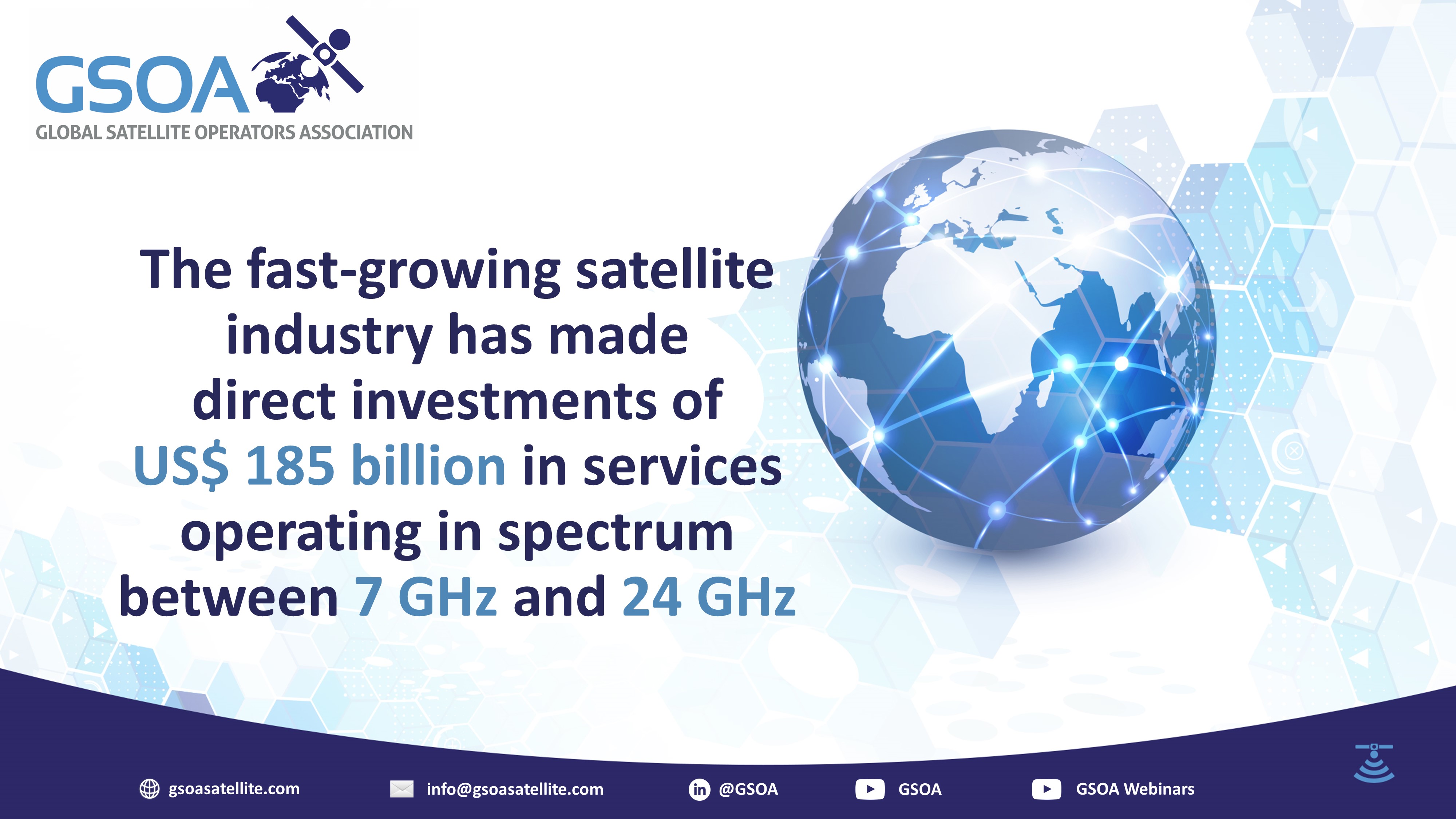Satellite Services Delivering Major Economic Benefits According to GSOA Report
Brussels, Belgium, August 1, 2023 – Investments in satellite services operating in the 7 GHz to 24 GHz frequency range have generated economic benefits of more than US$ 555 billion, according to a new report by Plum for GSOA. The consulting firm found that ongoing access to these spectrum bands, which are the subject of several agenda items at the forthcoming World Radiocommunication Conference (WRC-23)[1], is of critical importance to the satellite industry and its customers.
Plum estimates that satellite operators have made direct investments of US$ 185 billion in services operating in spectrum between 7 GHz and 24 GHz, which have yielded indirect investment benefits of US$ 370 billion. The report notes that usage of the satellites is generating further socio-economic benefits, which will be worth more than the US$ 18 billion spent annually on operating services in these spectrum bands.
 "Satellites services in the 7 to 24 GHz frequency range have huge value, both to the consumers using them and to society as a whole,” said Isabelle Mauro, Director General of GSOA. “It is vital that this spectrum continues to be available to the fast-growing and economically-essential satellite sector, which is expected to connect over 500 million people worldwide to broadband services by 2030,” she added.
"Satellites services in the 7 to 24 GHz frequency range have huge value, both to the consumers using them and to society as a whole,” said Isabelle Mauro, Director General of GSOA. “It is vital that this spectrum continues to be available to the fast-growing and economically-essential satellite sector, which is expected to connect over 500 million people worldwide to broadband services by 2030,” she added.
The new report details how satellites operating between 7 GHz and 24 GHz are widely used to bring broadband to unserved and underserved communities, extending digital inclusion and widening end-user choice, while also providing vital safety and emergency assistance services.
Although there have been some calls to consider parts of the 7 GHz to 24 GHz range for international mobile telecommunications (IMT), a significant amount of spectrum has already been identified for use by IMT, both below 7 GHz for low and mid bands and in the mmWave bands (i.e. above 24 GHz). However, the majority of countries have allocated less than half of the identified spectrum to IMT, according to a second forthcoming report [2] by Plum. “Future growth in demand for mobile services is uncertain, but the current low uptake of mmWave spectrum indicates that there is scope for growth in this area,” that report notes. “Regulators and governments should be encouraged to focus on assigning spectrum in existing identified bands, and making most efficient use of this.”
At the same time, a number of WRC-23 agenda items seek to enable additional satellite applications to use spectrum within the 7 to 24 GHz range, which further demonstrates that this spectrum is heavily occupied: the number of operational satellites quadrupled between 2017 and 2022.
Large numbers of small satellites (ranging from a few kilograms up to 600 kilograms) are being deployed in non-geosynchronous stationary orbits (NGSO) to provide low latency communication services, accurate positioning, navigation and timing. There is also increasing demand for reliable and high data rate (>100 Mbps) GSO and NGSO satellite broadband services for aircrafts, ships, trains, trucks and coaches when they are out of reach of terrestrial networks. At the same time, satellite-enabled IoT services are being used to support real time asset tracking, monitoring and remote surveillance.
Plum notes that satellites’ continued use of 7 GHz and 24 GHz spectrum will bring large-scale socio-economic benefits, and there are no alternative bands that could support key satellite applications using current technologies available.
The report, ‘Assessing the use by satellite of spectrum in the 7 to 24 GHz bands’, is available on GSOA website.
GSOA is the only global non-profit association of the entire satellite ecosystem that brings members together and serves as the premier platform for worldwide collaboration. As the only CEO-driven satellite association in the world, GSOA takes the lead in addressing global challenges, seizing opportunities, and providing a unified voice for the satellite industry.
[1] The World Radiocommunication Conference 2023 (WRC-23) is scheduled to take place in Dubai in November and December 2023
[2] To be published by mid-August 2023





